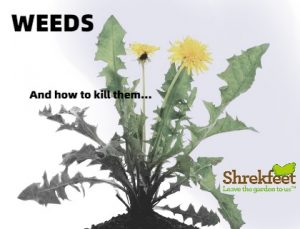 When is a weed not a weed?
When is a weed not a weed?
Weeds can be described as any plant growing in an area where it is not wanted. If that daffodil is in your rose-bed it might be considered a weed. If your lawn grass is in your flower-bed it most certainly is a weed.
Weeds can be relatively small like clover, or large like thistles. They are typically fast growing and spread rapidly, impacting on plant growth in and around them. Weeds
are characterised as narrow leafed like grasses, broad-leafed liked dandelions or woody like brambles. Large weeds can often be removed by hand, but removing smaller weeds from your lawn may require an effective pesticide.
What is the best weedkiller to use?
Pesticides used for treating weeds are often called herbicides.
There are two types of herbicides;
- Selective herbicides control only certain types of weeds, typically either broad-leafed or grass-like weeds.
- Nonselective herbicides control and kill all plant types with which they come into contact e.g. Glyphosate based shop bought weedkillers.
The application of a broad-leaf herbicide will affect and control the growth of broad-leaf plants. This type of herbicide is used by professional lawn care companies and it can usually be applied onto existing lawns, to selectively control only broadleaf weeds. The lawn is left unaffected.
To control grass-like weeds in the flower beds & borders, a grass herbicide is used. Grass herbicides can safely be applied to flower beds and will have no impact on broadleaf plants (e.g. your plants & shrubs), but will control and impact on grasses growing where they are not wanted.
How weed killers work
Some work by disrupting the fine balance of biochemical processes that occur within the plant. Often causing uncontrolled growth, twisting, thickening, elongation, and eventually death. The weed literally grows itself to death. Others target photosynthesis, the process where plants produce energy from sunlight. Blocking photosynthesis is only part of the story. When photosynthesis is blocked, highly toxic oxygen (strange but true fact!) and other compounds form & concentrate within the plant. These compounds rapidly destroy cell membranes, causing the weed to die.
Many selective herbicides target enzymes within plant cells. Enzymes allow complex chemical reactions to occur. When herbicide targets an enzyme it disrupts the sequence of complex chemical reactions a healthy growing plant relies on, producing highly toxic compounds in the plant and killing the weed.
So why don’t selective herbicides kill the useful plants we are trying to grow?
The main reason is that the useful plants are able to metabolise (break down) the herbicide more rapidly than the weeds, allowing them to survive.
When to use weed killers
Herbicides are most effective on actively growing plants, as the active ingredient is carried by the sap of the plant. The faster the plant is growing, the quicker the solution will be moved through the plant. Weeds, like most plants grow fastest during the Spring to Autumn season, so we offer seasonal lawncare & weed killer treatments at different times of the year. This keeps your lawn at its best all year round.
Application during less active growth periods are also effective, but the results will take longer.
Know your weeds
Weed plants fall into different families. Much like sprouts and cabbage are different plants but within the same group of plants, some weeds are in the same family group and some in different groups. Certain plant groups are susceptible to certain herbicides that other groups might not be affected by.
Identifying what weed you need to kill
Understanding which plant group a weed belongs to and what pesticide needs to be used to treat that specific group is the key to weed killing success. All herbicides have application rates, much like medication you take at home. There is a safe & optimal recommended dose. Exceed the dose and you may cause issues, take too little and there may be no effect.
Getting the dose right isn’t just about how much you pour out of the bottle, it’s also about how much water you add to the mix and how much of the mix is applied to the weed.
Is one application enough?
If you select the correct herbicide for the weed you aim to kill, use the correct dose rate and apply at the right time then often one application is often enough.
However, some weed varieties are more resilient than others. Some have thick leaf coatings or hairs that reduce the contact of the droplets of pesticide that have been sprayed on the weeds. Some weeds are persistent and are not controlled after just one application and several, consecutive applications may be required.
Applications may be necessary throughout the growing season and should continue until the weeds have been successfully controlled. Failing to do so may increase the weed’s resistance to the type of pesticide used – much like the risks of not finishing a course of antibiotics. Often additives can be used along with the pesticide to
increase the efficacy of the chemicals present.
Remember, weeds are fast growing and quick to set and disperse seed. These seeds germinate to form new weeds, so regular herbicide applications are essential.
Proper weed control & herbicide use is relatively complex, which is why you must hold a suitable qualification as a paid professional using herbicides to control weeds.
If you ask your regular gardener to do it, and he or she doesn’t hold a licence, then you are both breaking the law.
The general code of practice covering the use of herbicides states that you should attempt other forms of control before you start to use them to control a weed issue.
For effective & holistic lawn weed control, speak to us today.
[cta_wide cta_type=3]

 Established 2016
Established 2016



